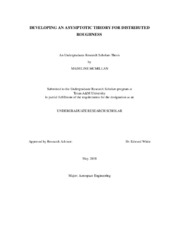| dc.creator | McMillan, Madeline Nicole | |
| dc.date.accessioned | 2018-05-23T15:33:13Z | |
| dc.date.available | 2018-05-23T15:33:13Z | |
| dc.date.created | 2018-05 | |
| dc.date.submitted | May 2018 | |
| dc.identifier.uri | https://hdl.handle.net/1969.1/166474 | |
| dc.description.abstract | Recent experiments have shown how distributed roughness fields have the potential to delay transition caused by large discrete roughness elements. This ‘shielding effect’ seems to indicate a shifting of the boundary layer over the roughness field, allowing protruding roughness elements to extend further into the freestream without causing transition. Currently, no theoretical model exists to correctly describe the flow physics over a distributed roughness field. A model would allow efficient computational study of such fields, as well as enhance understanding of distributed roughness transition mechanisms. Asymptotic analysis, similar to the analysis used to create triple-deck theory, is examined herein for its ability to provide potential scaling solutions to characterize many different types of roughness fields. It is shown herein that previous experiments on distributed roughness fit within the scaling bounds used to characterize triple deck theory, and can therefore be modified and extended to distributed roughness. | en |
| dc.format.mimetype | application/pdf | |
| dc.subject | Distributed roughness, triple deck theory, boundary layer stability and transition, shielding | en |
| dc.title | Developing an Asymptotic Theory for Distributed Roughness | en |
| dc.type | Thesis | en |
| thesis.degree.department | Aerospace Engineering | en |
| thesis.degree.discipline | Aerospace Engineering | en |
| thesis.degree.grantor | Undergraduate Research Scholars Program | en |
| thesis.degree.name | BS | en |
| thesis.degree.level | Undergraduate | en |
| dc.contributor.committeeMember | White, Edward B | |
| dc.type.material | text | en |
| dc.date.updated | 2018-05-23T15:33:14Z | |


